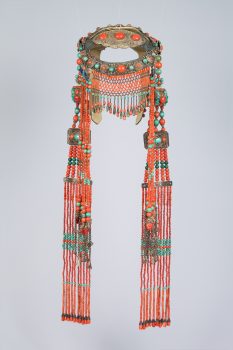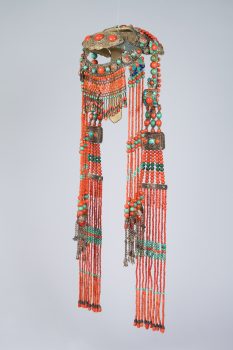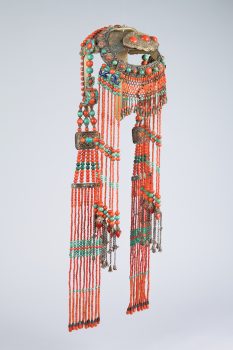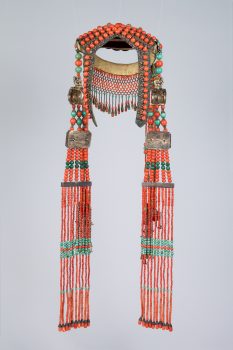Inner Mongolia
late 19th century




Inner Mongolia
late 19th century




This woman’s headdress (Mongolian: djasal) comes from one of the eight banners of Chakhar (Chahar) in central Inner Mongolia. The frame is a decorated silk-covered cloth bonnet featuring a headband with a continuous row of silver ornaments, which alternate between openwork filigree tied with turquoise beads and rosettes set with coral. Above the frame a large scalloped silver headpiece decorated with filigree is set with three large coral pieces. A net and fringe of coral, turquoise, and silver beads hangs over the forehead of the wearer.Long strings of coral and turquoise beads, which hang from ornaments in the shape of stylized butterflies, frame the face of the wearer. These long strands end in auspicious images, including silver bats holding peaches which are in turn carved from lozenge-shaped red carnelian, imagery that means in Chinese “may you possess both blessings and longevity” (福壽雙全). From the wings of the bats hang a strand of tiny silver beads with an endless knot and a pair of bell-shaped finials. A long pair of heavy ear-ornaments (süike) and a pair of silk-covered lapels decorated with large coral beads complete the presentation.
While the primary religious goal for followers of Buddhism is enlightenment, many of the practices also serve secular goals related to daily life, including ethical conduct and cultivating well-being.
Mongolians have been widely active in the Tibetan Buddhist world, playing a key role in Tibetan culture, politics, and relations with China. In the 13th century, the Mongol Empire—the largest contiguous empire in world history—facilitated the spread of Tibetan visual culture.
Get the latest news and stories from the Rubin, plus occasional information on how to support our work.